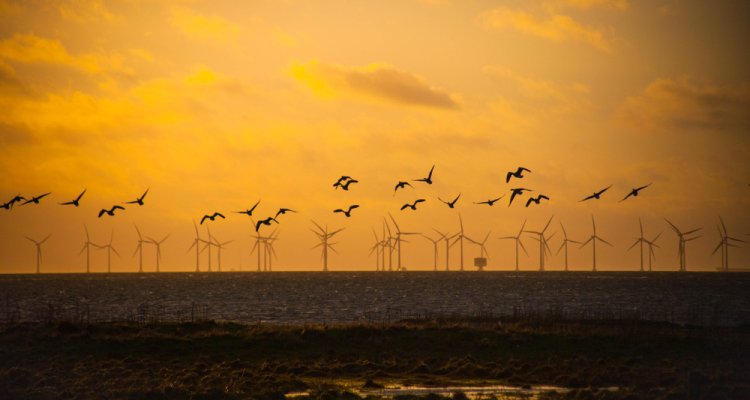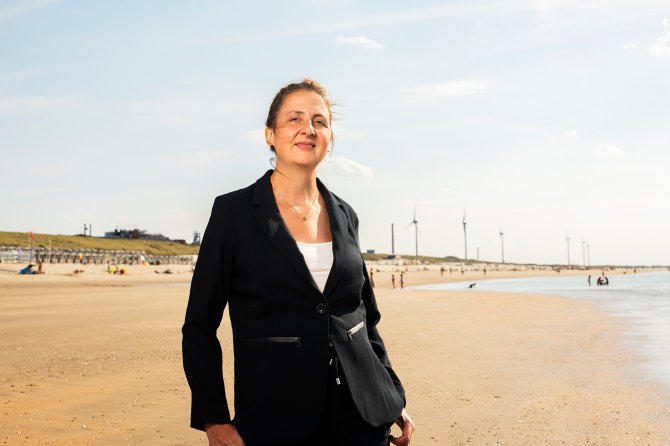
News
Air bubble curtains protect seals against noise
North Sea offshore wind energy is becoming the most important source of energy for the Netherlands. Wind energy is clean and never runs out, except there are disadvantages for the animals in and above the sea, says Josien Steenbergen of Wageningen Marine Research. ‘We are studying the risks and how to reduce them.’
Many wind farms will be constructed in the North Sea in the years ahead. The Netherlands Environmental Assessment Agency (PBL) expects that by 2050, possibly a quarter of the Netherlands’ wind farms will be offshore in the North Sea. The sea will look very different when seen from below and above the water’s surface. This scaling-up does entail necessary risks, says Josien Steenbergen, research coordinator for offshore wind energy. Commissioned by the government and wind energy sector, Wageningen Marine Research conducts research into the consequences of offshore wind farms for animal species. This knowledge will help government authorities determine which locations are suitable and less suitable for wind farms and in which seasons offshore pile driving activities can best be carried out.
Bat migration
Direct effects include birds and bats flying against the blades, says Steenbergen. ‘Some don't survive the impact.’ But there are also longterm consequences: there are species of birds that have no problems with wind farms, for example the cormorant, whereas the northern gannet, a large seabird, circumnavigates wind farms in a really wide arc. ‘Maybe those were places where they usually sought food or a place to rest. This may have an effect on the numbers.’
Earlier research by Wageningen Marine Research showed that not only several bird species, but bats (Nathusius’ pipistrelle) migrate back and forth across the North Sea. Researchers found that bats fly with a tailwind: in the autumn they fly from the Netherlands to England with an easterly wind and they return in the spring with a westerly wind. Thanks to this research, nowadays wind farm operators bring their turbines to a standstill at those times.
Preventing hearing impairment
Even underwater, wind turbines have all kinds of effects on animals. Current research into the effects of offshore wind farms on porpoises and seals, focuses on the impact of pile driving during construction of the wind farms. ‘They have highly sensitive hearing with which they detect prey and communicate with each other’, says Steenbergen. ‘Because of the pile driving, their hearing can be impaired permanently, preventing them from searching for food.’ Together with TNO, we also try to calculate the extent of the area where disruption takes place and the effects of such disruption. On the basis of this study, measures are taken to reduce the disruptions. An example is an innovation in which, in the process of pile driving activities, a curton of air bubbles are placed to protect the animals against much of the noise.

The study into the effects on underwater animals, once the wind farms are in place, is in full swing. This includes a study into the effects of electromagnetic fields on sharks and rays. A study has also been launched into the impact of the large-scale roll-out of offshore wind energy on the ecosystem. This study is jointly being undertaken by Deltares, Wageningen Marine Research and the NIOZ.
Positive consequences
Interestingly enough, the impact is not only negative. ‘For example, rocks are placed on the seabed to ensure that the turbines do not topple (scour protection)’, says Steenbergen. ‘Shellfish and other species grow on them, which enrichens biodiversity. Together with industry, we study how best to shape these scour protection so that the animals benefit from it.’ There are also initiatives to reintroduce oyster reefs in wind farms. These had disappeared in the North Sea over the last century due to overfishing, diseases and pollution. The fishing-protected wind farms can also offer opportunities for commercial seaweed cultivation, shellfish farming and passive fishing.
A great deal of research is still needed, but according to Steenbergen, the Netherlands is on the right track. Until 2016, wind farm owners in the Netherlands had to estimate the ecological effects themselves. Now this is centrally-based via Rijkswaterstaat’s ‘Offshore wind ecological programme (Wozep), commissioned by the Ministry of Economic Affairs and Climate. On the other hand, wind farm owners now have to include an ecological programme in their tender procedures. ‘Which was interesting as it suddenly gave our research a boost. Many wind farm owners are now asking us for advice or want to collaborate.’
Translation into policy
Wageningen Marine Research is involved in a massive ten-year research programme on the impact of wind farms on animal species and the ecology of the North Sea, which starts in early 2023. But before this MONS programme (Monitoring-Research-Nature improvement-Species protection) is completed, a huge number of wind turbines will be erected in the North Sea. ‘I hope government authorities will provide some leeway to adapt plans, if this proves necessary on the basis of our research results’, says Steenbergen. She is curious to know what this enormous upscaling means for the various species of animals. ‘The years ahead are going to be very exciting. Will politicians put our knowledge to good use? Will sufficient measures be taken to confine (any) adverse effects for animals and the ecosystem?’
This article was previously published in the TO2-magazine, November 2022.